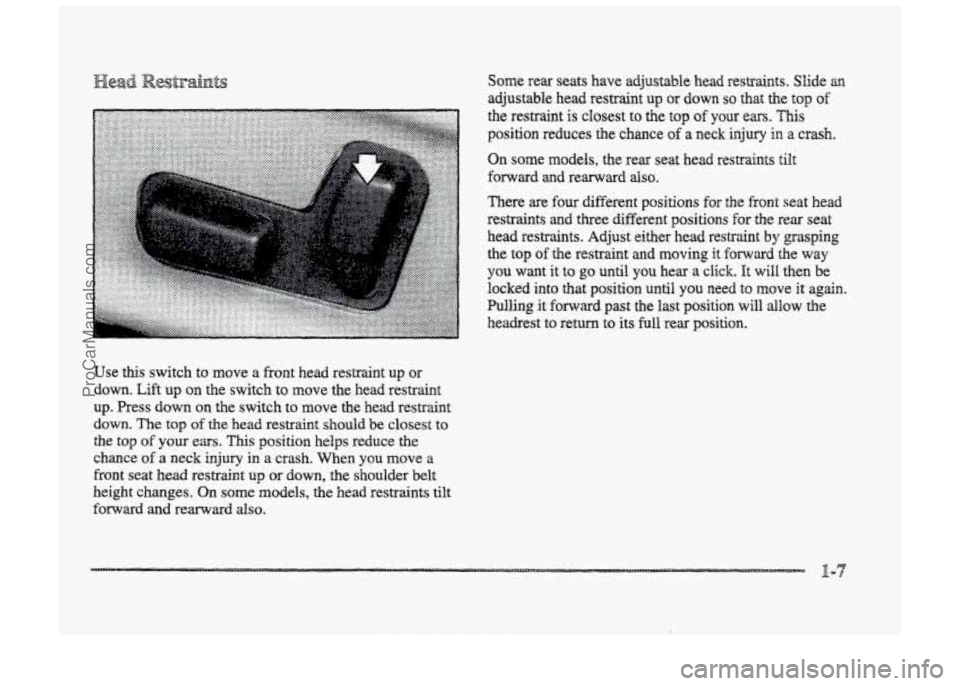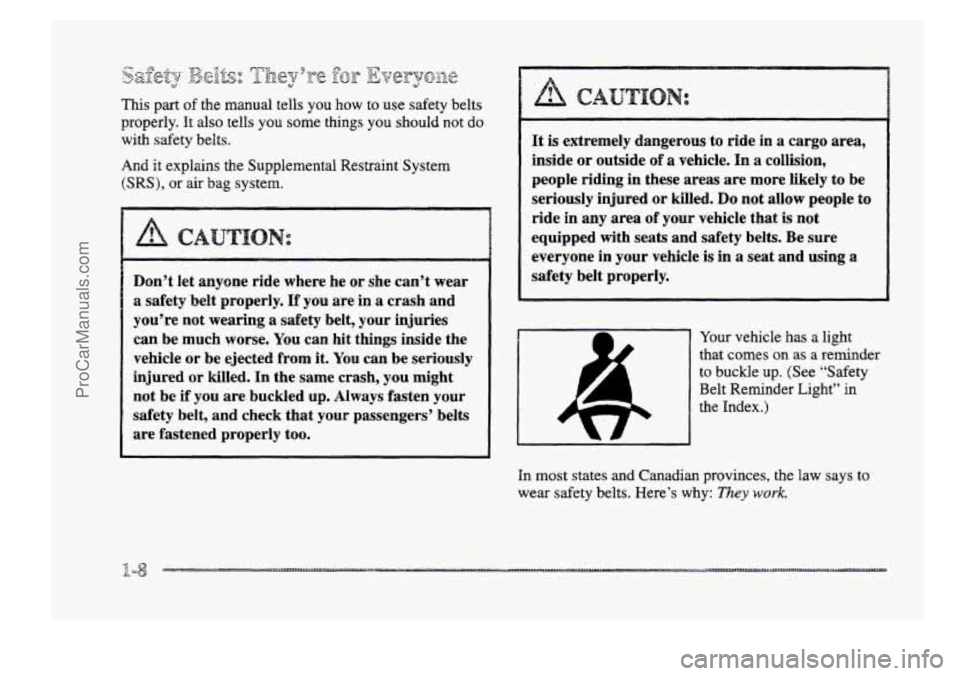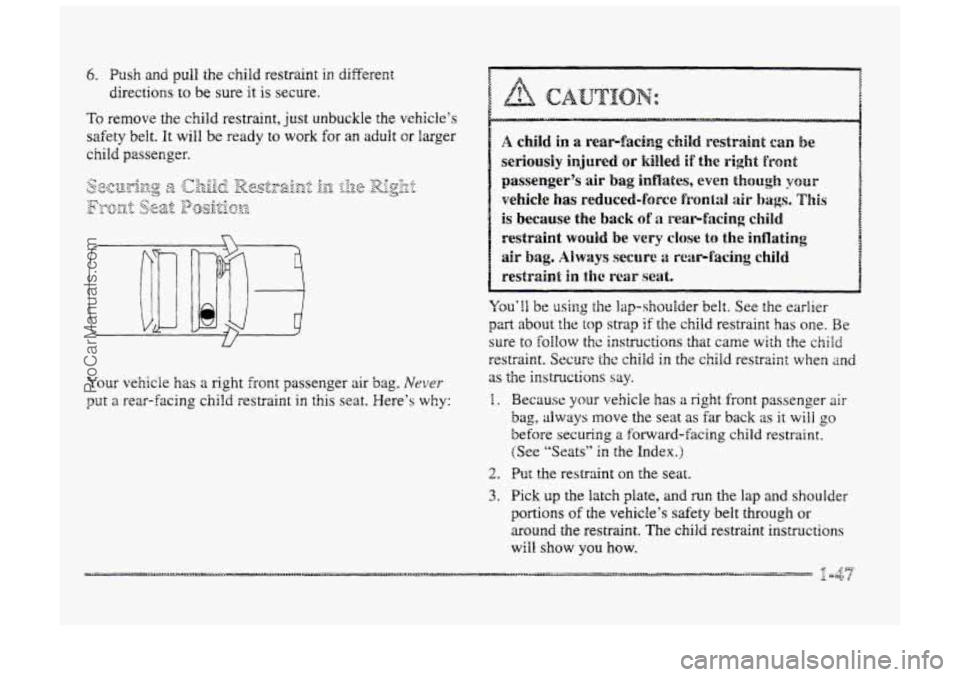Page 13 of 426
Here you'll find information about the seats in ycur Buick and how to use your safety belts propedy. You can also
learn about some things you should not do with air bags and safety belts.
1-2
1-8
1-12
1-13
1-13
1-20
1-21
1-28
B -27 Seats
and Seat Controls
Safety
Belts: They're for Everyone
Were
Are Questions Many Teogle Ask
About Safety Belts -- and the Answers
How to Wear Safety Belts Properly
Driver Position
Safety Beit Use During Pregnancy
Right
Front Passenger Position
Supplenental Restraint System
(SRS)
Center Passenger Position
1-28
1-32
1-34
1-37
1-47
9 -50
i -50
1-50
Rear Seat Passengers
Rear Safety Belt
CSITI€OI-~ Guides for
Children
and Small Adults
Children
Child Restraints
Larger Children
Safety Belt Extender
Checking Your
Restraint Systems
Replacing Restraint System
Parts After
a Crash
ProCarManuals.com
Page 14 of 426
'This part tells YQU about the seats -- how to adjust them,
and SO about memory seats, reclining seatbacks and
head restraints.
To increase or decrease supp~pt, hold the switch forward
or rearward. TO move the lumbar up md down, hold the
switch upward or d~wnward. Raise
QT Bower the fiont of the seat cushion by
holding the &ont part of the horizontal COII~~ up
or down.
ProCarManuals.com
Page 19 of 426

Use this switch to move a front head restraint up or
down.
Lift up on the switch to move the head restraint
up. Press down on the switch to move the
%led restraint
down. The top of the head restraint should be closest to
the top of
your ears. This position helps reduce the
chance
of a neck injury in a crash. When you move a
Eront seat head restraint up or down, the shoulder belt
height changes. On some models, the head restraints tilt
forward and rearward also.
Some rear seats have adjustable head restraints. Slide an
adjustable head restraint up or down so that the top of
the restraint is closest to the top of your ears. "his
position reduces the chace of a neck injury in a crash.
On some models, the rear seat head restraints tilt
f~r~ad md rearward dso.
There are four different p~sitions for the front seat head
restraints
and three different positions for elme rear seat
head restraints. Adjust either head
restsaint by grasping
the top
of the restraint and moving it f~l7;~lmd the way
you want it to go until YOU hear a click. It will then be
locked into that position until you need to move it again.
Pulling it
forward past the last position will allow the
headrest to return
to its full rear position.
ProCarManuals.com
Page 20 of 426

This part of the manual tells you how to use safety belts
properly. It also tells you some things you should not do
with safety beits.
And it explains the Supplemental Restraint System
(SRS), or air bag system.
~ ~ ~~~~
Don’t let anyone ride where he or she can’t wear
a safety belt properly. If you are in a crash and
you’re not wearing a safety belt, your injuries
can be much worse. You can hit things inside the
vehicle or be ejected from
it. You can be seriously
injured
or killed. In the same crash, you might
not be if you are buckled up. Always fasten your
safety belt, and check that your passengers’ belts
are fastened properly too.
i
i
1
~
It is extremely dangerous to side in a cargo area,
people riding in these areas
are more likely to be
seriously injured or killed.
Do not allow people to
ride in any area of your vehicle that is not
equipped with seats and safety belts. Be sure
everyone in your vehicle
is in a seat and using a
safety belt properly.
I inside or outside of a vehicle. In a collision,
..r Your vehicle has a light
that
comes on as a reminder
to buckle up. (See “Safety
Belt Reminder Light” in
the Index.)
In most states
and Canadian provinces, the law says to
wear safety belts. Here’s why:
They work.
ProCarManuals.com
Page 26 of 426
The driver has a lap-shoulder belt. Here’s how to wear
it properly.
1. Close and lock the door.
2. Adjust the seat (to see how, see “Seats” in the Index)
so you can sit up straight.
3. Pick up the Batch plate and pull the belt across you.
Don’t let it get twisted.
4. Push the latch plate into the buckle until it clicks.
Pull up on the latch plate to make sure it is secure.
E
the belt isn’t long enough, see “Safety Belt
Extender” at the end. of
this section.
Make sure the release
button on the buckle is
positioned so you would be able to unbuckle the
‘safety belt quickly i€ you ever had to.
ProCarManuals.com
Page 50 of 426
A rear-facing infant restraint (B) positions an infant
to face the rear of the vehicle. Wear-facing infant
restraints are designed
for infants of up to about
20 Ibs. (9 kg) agld about one year of age. "his type
of restraint faces the rear so that the infant's head,
neck
and body can have the support they need in a
crash. Some infant seats come in two parts -- the
base stays secured
in the vehicle and the seat part
is removable.
ProCarManuals.com
Page 52 of 426
.:~~~:.:.:.~~:.:.:.~:~.. ................ . ............._. ............
A booster seat (F, G) is designed for children who
are about
40 to 6Q Ibs. (18 to 27 kg) md about
four to eight years
of age. It’s designed to improve
the fit of the vehicle’s safety belt system. Booster
seats with shields use lap-only belts; however,
booster seats without
shields use lapshoulder
belts. Booster seats can
also help a child to see
out the window.
ProCarManuals.com
Page 59 of 426

6. Push and pull the child restraint in differezt
directions
to be sure it is secure.
To remove the child restraint, just unbuckle the vehicle’s
sa€ety belt.
It will be ready to work for an adult cr larger
child passenger.
U
YQUT vehicle has a right front passenger air bag. Never
put a rear-facing child restraint in this seat. Here’s why:
You’ll be using the lap-shoulder belt. See the earlier
part aboemt the top strap if the chiid restraint has one. Be
sure to FokBow the instructions that came with the child
restraint. Secure the child in the child restraint when and
as the instructions say.
1. Because your vehicle has a right front passenger air
bag, always move the seat as far back as it wi6i go
before securing a forward-facing child restraint.
(See “Seats” in the Index.)
2. Put the restraint on the seat.
3. Pick up the latch plate, and run the lap and shoulder
portions of the vehicle’s safety belt through or
around the restraint. The child restraint instructions
will show
you how.
- .. L - 7 &fcT
ProCarManuals.com